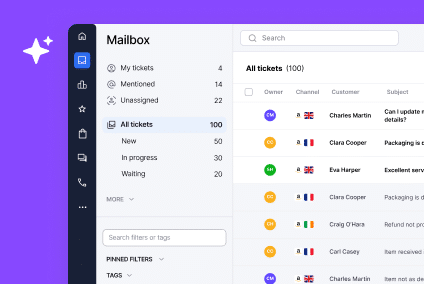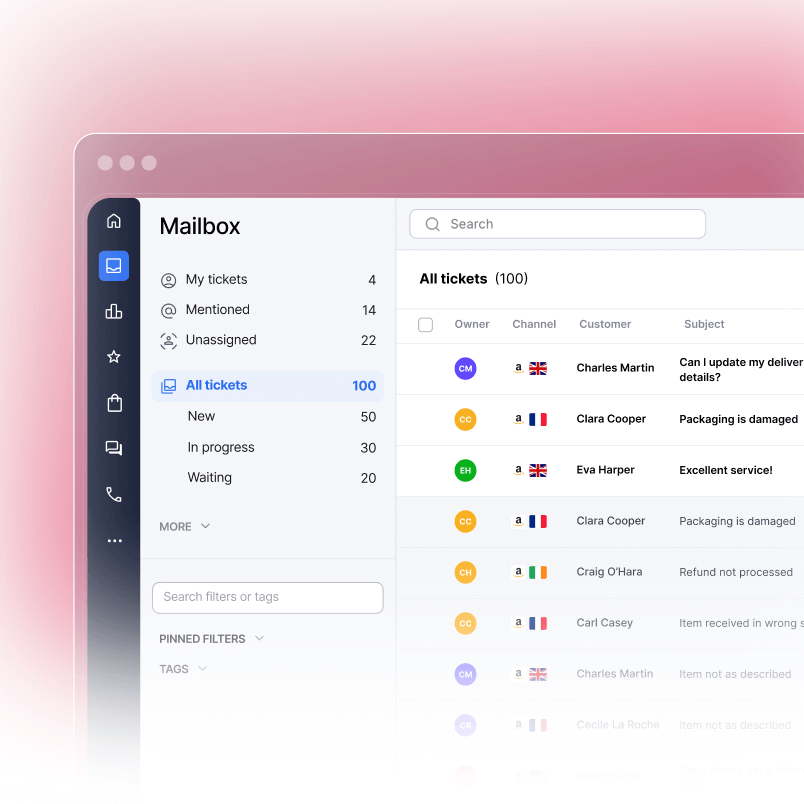Support teams spend too much time on repetitive work. Between reading the same questions, manually routing tickets, and hunting for the right response, your agents burn hours on tasks that AI can handle instantly.
The question isn’t whether AI helpdesks work. The real question is which features deliver results and which are just noise. This guide breaks down the AI helpdesk capabilities that actually reduce manual work, speed up resolutions, and cut costs. You’ll learn what to look for, how these features work in real workflows, and which platforms offer the best combination of tools.
What Is an AI Helpdesk?
An AI helpdesk is customer support software enhanced with machine learning and artificial intelligence logic. Unlike basic ticketing systems that follow fixed rules, AI helpdesks learn from your support patterns and adapt. They handle repetitive tasks, predict customer needs, and assist agents with smarter suggestions in real time.
The difference between rule-based automation and adaptive AI matters here. Rule-based systems follow predetermined paths: if ticket contains „return,“ apply rule X. AI systems go deeper. They understand context, tone, urgency, and customer history. They improve over time as they process more tickets.
Benefits show up fast. Teams report faster first response times, shorter resolution windows, lower costs per ticket, and fewer escalations. Agents spend less time on triage and typing, more time on solving problems that need human touch. With 80% of companies already using AI to improve customer interactions, the technology has shifted from experimental to essential. Learn more about how AI revolutionizes customer support and the top use cases ecommerce brands are seeing.
Core AI Helpdesk Features That Save Time
Sentiment Analysis
Sentiment analysis detects the emotional tone in customer messages. Is the customer frustrated, neutral, or satisfied? The AI flags this automatically as you read incoming tickets.
When sentiment analysis works right, your team prioritizes the angry customer over the casual inquiry. The system tags urgent emotional states and routes them to senior agents who excel at defusing tension. A customer with high frustration gets faster response time. The result: fewer escalations, faster resolutions, happier outcomes.
Most AI helpdesks run sentiment scoring in real time. The moment a ticket arrives, it gets scored and tagged. Your agents see the emotion level before they open the message, so they adjust tone and priority accordingly. AI systems incorporating emotional recognition improve customer satisfaction by up to 30%, according to MIT Media Lab.
Smart Ticket Routing
Manual triage wastes time. An agent spends 10 minutes reading each new ticket, deciding which agent should handle it, then sending it their way. Multiply that across hundreds of tickets daily and you lose massive productivity.
Smart routing uses AI to send tickets where they need to go automatically. Route by customer value (VIP customers to top-tier agents), urgency (based on sentiment or keywords), language (to bilingual agents), or issue type. The system learns your team’s specialties and matches tickets to the right person.
A VIP customer’s message now goes straight to your best agent without delay. A Spanish-language inquiry routes to your Spanish-speaking specialist instantly. A simple FAQ question routes to a newer agent for quick wins. No manager sitting in the middle sorting tickets manually.
Suggested Replies and Agent Assist
Your agents type the same responses hundreds of times. „Your order ships in 3-5 business days.“ „We don’t accept returns after 30 days.“ „Here’s your tracking number.“ The repetition is mind-numbing and slow.
Suggested replies use natural language processing to generate response options based on ticket content. The agent doesn’t type from scratch. They see two or three AI-drafted replies, pick the best one, tweak it if needed, and send. For routine inquiries, this cuts response time from 5 minutes to 30 seconds.
Agent assist works similarly. As the agent types, the system suggests words, phrases, or complete sentences to finish their thought. Think autocomplete, but for customer service. Teams using AI-enabled support save 45% of the time spent on calls and resolve issues 44% faster than those without AI.
AI Macros and Auto-Tagging
Macros let agents insert pre-written templates. But static macros miss opportunities. AI macros adapt based on the ticket content, customer data, and issue type. A return request pulls a different macro than a shipping question because the system understands the context.
Auto-tagging goes hand in hand with this. As tickets arrive, AI applies relevant tags automatically. „Return Issue,“ „Urgent,“ „Duplicate,“ „Refund Requested,“ „International.“ These tags feed into your reporting, routing rules, and knowledge base suggestions. You stop asking agents to tag manually. The system learns your tagging patterns and applies them consistently.
With accurate tagging, you gain visibility into your support workload. You see return issues spiking (maybe a product defect?). You spot duplicate complaints (customer communication problem?). You find trends that need attention.
Multilingual Support and Auto-Translation
Global ecommerce means customers write in multiple languages. Hiring enough bilingual agents is expensive. Auto-translation solves this without hiring headcount.
AI translates incoming messages into your team’s language in real time. Your English-speaking agent sees the customer’s Spanish message in English. They respond in English. The system translates your reply back to Spanish and sends it to the customer. The customer never knows their issue was handled outside their language. Your team serves global customers without staffing for every language.
The quality matters. Poor translation creates problems. Premium AI translation services handle context, slang, and nuance better than free tools. Investment in quality translation pays off in customer satisfaction and retention. Explore accurate AI translation software for support to see how it works in practice.
Ticket Deflection Tools
Not every issue needs an agent. Before escalating a ticket, a smart chatbot offers help articles or FAQ suggestions. If the customer finds the answer themselves, the ticket never reaches your queue.
Ticket deflection uses AI to predict which issues can resolve without an agent. A customer asks „How do I track my order?“ The chatbot suggests your tracking guide. Customer finds their answer, clicks resolved. Your agents skip that ticket entirely.
This reduces ticket volume without ignoring customers. Deflection isn’t dismissal. The system only suggests articles when it’s confident they’ll help. For complex issues, the ticket routes to an agent normally.
Knowledge Base Suggestions
Your knowledge base exists to reduce ticket volume. But how many customers find it before contacting support? Most don’t. They email you first.
AI knowledge base suggestions work proactively. When a ticket arrives, the system scans your knowledge base and surfaces the most relevant articles. The agent sees a „Did you know?“ suggestion. They can send the link to the customer, or if the link answers the question fully, the ticket resolves without back-and-forth.
Over time, high-quality knowledge base suggestions reduce repeat inquiries. Customers learn where to find answers. Your support load drops. Building a knowledge base from the start helps teams deflect tickets early and scale without adding agents.
Real-World Workflow Example
Here’s how these features work together in actual practice.
A customer emails your Shopify store at 2 PM on Friday. They’re angry their order hasn’t shipped. The message reads: „This is ridiculous! I ordered 4 days ago and still no tracking number. Where is my order??? I need it by tomorrow!“
The AI helpdesk springs into action.
Sentiment analysis reads the message and flags it as highly negative and urgent. The system scores it 8.5 out of 10 for frustration. It tags the ticket „Urgent,“ „Angry Customer,“ and „Shipping Inquiry.“
Smart routing sees the priority and urgency score. Instead of going to a new agent, the ticket routes to Sarah, your most experienced agent who specializes in shipping issues and customer recovery.
As Sarah opens the ticket, the system shows suggested replies. It pulls her previous responses to similar shipping issues and generates three reply options. Sarah picks the first one, personalizes it with the order number, and hits send. The customer gets a reply within 5 minutes instead of the standard 30-minute window.
Sarah’s reply includes a link to the customer’s tracking number and an explanation of your shipping timeline. She also offers a 10% discount on their next order as a goodwill gesture.
Result: fast resolution, defused anger, customer retention. Without AI, this ticket bounces between agents, waits in queue for 30 minutes, and the customer leaves a bad review.
Top AI Helpdesk Platforms with These Features
Several platforms excel at blending these AI features with solid helpdesk infrastructure.
eDesk combines multi-channel support (Shopify, Amazon, eBay, BigCommerce) with built-in AI routing, suggested replies, and auto-tagging. Teams report 35-40% improvement in first response time within the first month. The platform connects directly to your store data, so routing and tagging use real customer context. Shopify and BigCommerce sellers particularly benefit from native integrations. Learn more about eDesk’s AI ticketing support and how to automate your ecommerce workflows.
Freshdesk with Freddy AI offers auto-triage, agent assist, and knowledge base recommendations. The platform routes tickets based on skills, workload, and language. Freddy generates suggested responses and learns from your team’s best practices. Smaller teams find it straightforward. Mid-market companies scale it smoothly.
Zendesk AI provides auto-tagging, routing, and a bot builder for FAQ deflection. The platform has strong automation rules and integrates with most tools. It scales well but requires more configuration upfront. Larger enterprises often choose Zendesk for its breadth and flexibility.
Gorgias focuses on ecommerce and integrates with Shopify, BigCommerce, and Amazon. Their AI detects customer intent from messages, routes smartly, and suggests knowledge base articles. Reviewers praise the Shopify integration and fast implementation. The platform shines for direct-to-consumer brands.
Feature comparison:
| Platform | Sentiment Analysis | Smart Routing | Suggested Replies | Auto-Translation |
| eDesk | Yes | Yes | Yes | Yes |
| Freshdesk (Freddy) | Yes | Yes | Yes | Yes |
| Zendesk | Yes | Yes | Yes | Yes |
| Gorgias | Yes | Yes | Yes | No |
How AI Helpdesks Save Time and Costs
Numbers matter. Here’s what teams see when they implement AI helpdesk features.
First response time improves dramatically. 80% of companies already use AI to improve customer interactions, while 95% of decision-makers report reduced costs and time savings. Teams using AI helpdesks with smart routing and suggested replies cut response time from the industry standard of 2-4 hours to 15-45 minutes. Urgent tickets flagged by sentiment analysis drop to under 10 minutes.
Resolution time shrinks as well. When agents spend less time on triage and more on solving, teams achieve 87% reduction in average resolution times and 45% reduction in call handling times. For high-volume support operations, this compounds quickly.
Cost per ticket drops significantly. Companies that use AI-powered customer service reduce support costs by up to 30%. Companies that adopt AI-driven workflows report a 25% reduction in support costs and significant boosts in customer satisfaction. Some teams reduce support staffing by 15-20% without impacting quality. Others keep staffing steady and redirect hours to higher-value work like customer proactive outreach.
Real-world examples show major impact. Unity saved $1.3 million deflecting 8,000 tickets with AI. Klarna’s AI assistant held 2.3 million customer conversations within the first month, representing two-thirds of their total customer service interactions. The AI system led to a 25% drop in repeat inquiries, with customers resolving issues in just two minutes instead of 11 previously.
Escalation rates fall. When angry customers reach experienced agents faster, fewer situations explode into bigger problems. Some teams report 20-30% fewer escalations once sentiment analysis routes urgent tickets to specialists.
Customer satisfaction lifts. Faster responses, more accurate routing, and fewer back-and-forth exchanges create happier customers. 92% of customer service leaders admit that AI has improved their customer service response. Companies that leverage AI report a 50% increase in customer satisfaction year-over-year compared to their competitors. Retention also improves because customers feel heard.
Final Insights
AI helpdesk features deliver real results when implemented strategically. Sentiment analysis stops problems before they escalate. Smart routing gets the right ticket to the right agent instantly. Suggested replies and agent assist compress response time by half. Auto-tagging and auto-translation scale your team’s capacity without hiring.
The platforms that combine these features well, like eDesk, Freshdesk, and Gorgias, adapt to your workflow instead of forcing you into rigid processes. Your team spends less time on busywork and more time on genuine problem-solving.
If your support team is overwhelmed, response times are slipping, or agents complain about repetitive work, AI helpdesk features are worth testing. Most platforms offer free trials. Start with one feature, see the impact, then layer in others as your team gets comfortable. The time you save compounds quickly.
By 2025, 86% of customer service professionals will have tested or implemented AI solutions, and 95% of customer interactions are expected to be AI-powered. The question isn’t if your team will use AI. It’s when. Early adopters gain faster response times, lower costs, and happier customers. Your competitors are already moving. Consider starting your implementation with a platform designed for eCommerce, like eDesk’s AI automation strategies, to see results within your first 30 days.
FAQs
What is an AI helpdesk?
An AI helpdesk is customer support software that uses machine learning to automate routine tasks, route tickets intelligently, and assist agents with suggestions. Unlike basic ticketing systems that follow fixed rules, AI helpdesks learn from your support patterns and adapt to your team’s workflow. 80% of companies now use AI to improve customer interactions.
How does sentiment analysis work in support tools?
Sentiment analysis scans the language in customer messages and scores the emotional tone on a scale. The system flags high frustration or anger, tags the ticket accordingly, and routes it to experienced agents. This prevents angry customers from bouncing between agents or waiting in queue. AI systems incorporating emotional recognition improve customer satisfaction by up to 30%.
Can AI fully replace human agents?
No. AI excels at repetitive tasks, triage, and suggestion. It cannot replicate empathy, judgment, or complex problem-solving. The best results come from blending AI efficiency with human expertise. AI handles what’s routine. Agents focus on what’s complex or emotional. 44% of high-performing organizations report that AI integration eliminates manual and repetitive tasks while agents handle complex issues.
Which AI helpdesk is best for Shopify or DTC brands?
eDesk and Gorgias both integrate directly with Shopify and pull store data into your support workflow. They route based on real customer information and order history. For BigCommerce stores, eDesk also offers native integration. Both platforms deliver the fastest implementation and best results for direct-to-consumer brands. Learn more about how eDesk helps Shopify sellers automate their customer support.
What’s the typical cost of an AI helpdesk?
Most AI helpdesk platforms charge per agent or per seat, ranging from $50-$150 per user monthly. Some charge by ticket volume. Free trials let you test before committing. The ROI typically appears within the first 60-90 days through reduced response time and faster resolutions. Companies see an average return of $3.50 for every $1 invested in AI customer service.
How long does it take to implement an AI helpdesk?
Basic setup takes 1-2 weeks for most platforms. Integration with your ecommerce platform (Shopify, BigCommerce, etc.) happens within days. Training your team takes another week. Full optimization, where the AI learns your patterns and routing logic settles in, takes 30-60 days.
Does AI improve customer satisfaction?
Yes. Faster responses, smarter routing, and fewer escalations lead to higher satisfaction scores. 92% of customer service leaders admit that AI has improved their customer service response. Companies leveraging AI report a 50% increase in customer satisfaction year-over-year. eCommerce teams report NPS improvement within 90 days. The gains come from customers feeling heard faster and talking to the right agent the first time.




